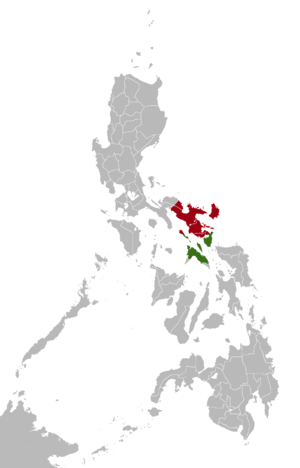Bikol languages
| Bikol | |
|---|---|
| Geographic distribution: | Bicol Region |
| Linguistic classification: | |
| Subdivisions: | |
| ISO 639-2 / 5: | bik |
| Glottolog: | biko1240[1] |
|
Geographic extent of Bikol languages according to Ethnologue
Bikol proper
| |

The Bikol languages are a group of Central Philippine languages spoken mostly on the Bicol Peninsula of the island of Luzon and also parts of Catanduanes and Burias Islands and Masbate province. There is a dialect continuum between the Visayan languages and the Bikol languages; the two together are called the Bisakol languages.
Internal classification
Ethnologue
The languages of Bikol grouped according to Ethnologue are:
- Coastal Bikol (Northern)
- Inland Bikol (Southern)
- Mount Iriga Agta language
- Albay Bikol languages
- Rinconada Bikol language
- Highland / Sinabukid dialect
- Agta variant
- Iriga variant (standard)
- Lowland / Sinaranəw dialect
- Baao variant
- Bato variant
- Bula-Pili variant
- Nabua-Balatan variant
- Highland / Sinabukid dialect
- Northern Catanduanes Bikol (Pandan Bikol)
McFarland (1974)
Curtis McFarland gives the following classification for the Bikol languages.[2]
| Bikol |
| ||||||||||||||||||||||||||||||||||||||||||||||||||||||||||||||||||
| |
Lobel (2000)
While McFarland (1974) splits Bikol into 11 dialects, Lobel (2000) splits Bikol into 12 different dialects (including Partido Bikol, which McFarland does not differentiate) and 4 main branches.[3]
- Central Standard – Spoken primarily in Naga City. Also recognized (and sometimes understood) in Daet, Camarines Norte and many other areas of Camarines Sur; San Pascual, Masbate on Burias Island; Legazpi City and other cities along the eastern coast of Albay, southwestern coast of Catanduanes, and northeastern Sorsogon.
- Daet area variant
- Naga City area variant
- Eastern Standard Bikol – Spoken in and around Legazpi City, Catanduanes southern town of San Andress and Caramoran and North Sorsogon
- Partido – Spoken in the Camarines Sur municipalities of Ocampo, Goa, Tigaon, Lagonoy, Sagñay, and San Jose. This dialect has a mellow intonation and is heavily influenced by Riŋkonāda.
- South Catanduanes – Spoken in the southern half of Catanduanes.
- Virac area variant
- Bato area variant
- San Miguel variant (transitional to North Catanduanes)
- Southern Coastal and Inland Bikol
- Riŋkonāda – Spoken primarily in Iriga City, Baao; Bula; Balatan; Baao; and Nabua, Camarines Sur. Also in Ocampo, Buhi and Pili in Camarines Sur and in parts of Polangui, Albay.
- Buhinon – Spoken in Buhi, Camarines Sur. Contains features from both Bikol of Polangui and Bikol of Iriga.
- Libon – Spoken in Libon, Albay.
- West Miraya – Spoken in Ligao City, Polangui, Oas, and Pio Duran, Albay.
- East Miraya – Spoken in Guinobatan; Camalig; Daraga; Jovellar, Albay; Donsol and Pilar, Sorsogon.
- Central (Guinobatan)
- Far East (Camalig, Daraga)
- Southeast (Jovellar, Albay, Donsol, Pilar)
- Northern Catanduanes (Pandan) – Spoken by about 80,000 people in the Northern Catanduanes towns of Caramoran; Pandan; Bagamanoc; Panganiban, and Viga.
- Bisakol
- Central Sorsogon – Spoken in Sorsogon City; Castilla; Casiguran; and Juban, Sorsogon.
- Southern Sorsogon also known as Gubat language – Spoken in Gubat; Barcelona; Bulusan; Santa Magdalena; Matnog; Irosin; and Bulan, Sorsogon.
- Masbatenyo – Spoken in Masbate City; Mobo; Uson; Dimasalang; Palanas; Masbate; Aroroy on the island of Masbate, all of Ticao Island, and Claveria on the southern half of Burias Island.
- Standard Masbatenyo
- Ticao Island variant
Some dialects of Southern Bikol have the close central unrounded vowel /ɨ/ as a reflex of Proto-Austronesian *e. However, Proto-Austronesian *e is realized as /o/ in Libon. Two Bikol dialects have unique additional consonants, namely Southern Catanduanes, which has an interdental lateral consonant /l̟/ (also transcribed as l̪͆ ),[4][5] and Buhi-non, which has the voiced velar fricative /ɣ/.[6]
References
Notes
- ↑ Nordhoff, Sebastian; Hammarström, Harald; Forkel, Robert; Haspelmath, Martin, eds. (2013). "Bikol". Glottolog. Leipzig: Max Planck Institute for Evolutionary Anthropology.
- ↑ McFarland, Curtis D. The Dialects of the Bikol Area. Ph.D. dissertation. New Haven: Dept. of Linguistics, Yale University, 1974.
- ↑ Lobel, Jason William, Tria, Wilmer Joseph S., and Carpio, Jose Maria Z. 2000. An satuyang tataramon / A Study of the Bikol Language. Naga City, Philippines: Lobel & Tria Partnership, Co.: Holy Rosary Minor Seminary.
- ↑ http://scholarspace.manoa.hawaii.edu/bitstream/handle/10125/1772/olson.html
- ↑ https://vagabonddrifter.wordpress.com/2012/03/17/interdental-lateral/
- ↑ Lobel, Jason. 2009. "Bikol". In Concise Encyclopedia of Languages of the World, 158-161. Oxford: Elsevier.
General references
- Lobel, Jason William; Tria, Wilmer Joseph S. and Carpio, Jose Maria Z. 2000. An satuyang tataramon / A Study of the Bikol Language. Naga City, Philippines: Lobel & Tria Partnership, Co.: Holy Rosary Minor Seminary.
External links
- Translate Bikol, an online English-Bikol and Bisakol languages translator.
| ||||||||||||||||||
| ||||||||||||||||||||||||||||||||||||||||||||||||||||||||||||||||||||||||||||||||||||||||||||||||||||||||||||||||||
| ||||||||||||||||||||||||||
